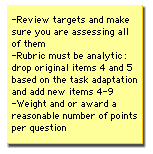|
For each performance assessment in the PALS
library, information on the rubrics and scoring is shown on the
Rubrics page. When adapting the rubric for a task, you will need
to examine this page. The text below shows a sample adaptation of
the Rubric for the "Containers" performance task.
Red
text shows modified or added text.
notes explain the changes and purple
text will be eliminated in the final adaptation.
Containers
Rubrics
Criteria for Fully-Correct Response
Item 1 - Measure temperatures and record data in table. Student
is scored both on proper use of the thermometer and on the quality
of data gathering.
Ability to use thermometer. Does not require assistance in
proper use
of the thermometer (Based on administrator notes on any special
assistance provided.)
Total Possible Points: 1
Quality of data gathering. i) Records times and temperatures
for 5 or more temperature points per container. ii) Times cover
full 10 minutes range. iii) Trend in the temperature is reasonable:
temperature declines with time in one or more of the cups. (One
cup may be too well insulated to give measurable declines in
10 minutes.)
Total Possible Points: 3
Item 2 - Identify container that keeps hot drink warm longest.
i) Identifies correct (based on administrator notes). ii) Container
identified is consistent with the data in table.
Total Possible Points: 2
Item 3 - Explain why container retains heat. i) Relates material
of containers to their ability to retain or transfer heat. ii) Includes
comparison of different containers based on heat transfer. iii)
Logically applies any additional relevant information (stirring,
thickness of container, size differences, etc.).
Total Possible Points: 2
Item 4 - Predict best container for keeping ice cream cold. Identifies
the same container that best keeps hot drink warm.
Total Possible Points: 1
Item 5 - Explain why container keeps ice cream cold. i) Relates
material of containers to their ability to retain or transfer heat.
ii) Includes comparison of different containers based on heat transfer.
iii) Logically applies any additional relevant information provided
(stirring, thickness of
containers, size difference, etc.).
Total Possible Points: 2
Item 4 - Predict best container for keeping ice water cold. Identifies
the same container that best keeps hot drink hot.
Total Possible Points: 1
Item 5 - Plan an experiment to identify which of three containers
keeps the ice water cold the longest. i) Put equal amounts of water
in each container, ii) Use water that is the same temperature, iii)
Take temperature recordings at the same time for each container,
iv) Take measurements over the entire ten minute period.
Total Possible Points: 3
Item 6 - Measure temperatures and record data in table. Student
is scored both on proper use of the thermometer and on the quality
of data gathering.
Ability to use thermometer. Does not require assistance in
proper use of the thermometer (Based on administrator notes
on any special assistance provided.)
Total Possible Points: 1
Quality of data gathering. i) Records times and temperatures
for 5 or more temperature points per container. ii) Times cover
full 10 minutes range. iii) Trend in the temperature is reasonable:
temperature declines with time in one or more of the cups. (One
cup may be too well insulated to give measurable declines in
10 minutes.)
Total Possible Points: 3
Item 7 - Identify the container that keeps the cold drink cold
longest. i) Identifies correct container (based on administrator
notes). ii) Container identified is consistent with the data in
table.
Total Possible Points: 2
 |
Item 8 - Explain why the container keeps the liquid cold. i) Relates
material of containers to their ability to retain or transfer heat.
ii) Includes comparison of different containers based on heat transfer.
iii) Logically applies any additional relevant information (stirring,
thickness of container, size differences, etc.).
Total Possible Points: 2
Item 9 - Explain how the same container minimizes heat transfer
for both hot and liquids. i) Relates material of containers to their
ability to retain or transfer heat. ii) Includes comparison of different
containers based on heat transfer. iii) Logically applies any additional
relevant information provided (stirring, thickness of containers,
size difference, etc.).
Total Possible Points: 3
Click
here to see another example of how to adapt the rubric
backtrack to adapting
targets, return to the PALS web site
or PALS Guide, or learn
more about rubrics and scoring.
|
